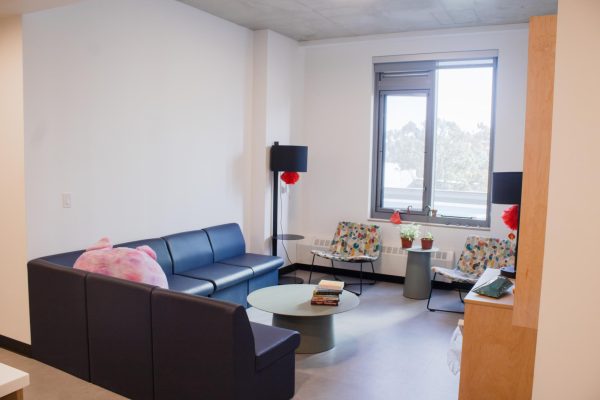Walking through UC San Diego’s campus, it is easy to see the discrepancies between buildings: newly erected and modern structures stand in contrast to faded and decaying buildings. This difference is particularly evident in on-campus housing. Housing conditions now differ exponentially between the different colleges with recently established colleges — Sixth College, Seventh College, and Eighth College — offering renovated and greatly improved living conditions. To solve this problem, the university could implement quality-based pricing or allow students to opt for cheaper or more expensive housing. However, these alternatives pose a form of institutional unfairness. The optimal solution is to properly allocate money and resources to renovate the older housing units to be on par with the newer units, ensuring equal housing quality and dorm life for the same price tag.

The pricing system currently in place allows freshman and sophomore students to rank their preference for a triple, double, or single room, each with different rates. However, a preference does not guarantee placement, as rooms are decided through a lottery system. Current rates list a triple in a residence hall for the price of $14,000, the cheapest option. On the other end of the spectrum, students are also offered a single room in an apartment-style dorm across all colleges for $17,000. However, this lottery system limits personal choice and there is no option for students to rate or choose what area or college dorm building they would like to live in. Currently, UCSD allocates dorm buildings to each college, and the college you are admitted to is based on admissions decisions, unrelated to housing.
This means that an Earl Warren College student who lives in a triple in a residence hall pays the exact same amount as a Seventh or Sixth student who lives in a triple in a residence hall. For comparison, a Warren triple is 9.5 feet by 15 feet, whereas a Seventh triple is 11 feet by 17 feet. Warren residence halls also do not have kitchens with fridges, or sinks, and “all appliances (e.g., cooking, portable heaters) with exposed heating elements are prohibited” per section 7a of Residential Life Standards. In comparison, all Seventh apartments have their own full kitchens and storage units. Although this disparity is not by design — as Seventh is much newer and originally built to house transfer students — the fact is that the difference in the quality of life between different colleges is astounding.
These differences extend to other colleges and other features, including but not limited to the number of bathrooms and toilets, living room square footage, window and lighting availability, and air conditioning and ventilation. College-wide amenities also differ drastically, with unequal laundry machine-to-student ratios and access to student-resident parking slots. Even public spaces for students to enjoy are not equal across dorm buildings. Colleges like Revelle College are essentially concrete jungles, while Eleanor Roosevelt College and John Muir College both have closer access to greenery and Sixth and Seventh apartments have oceanside views.

Given the astronomically different living conditions of different colleges, it is illogical that their housing costs are the same. For reference, a home in California costs an extra 2 million dollars, on average, if it has an ocean view compared to those that do not. Despite this, ocean-view dorms cost the same as a ground-floor apartment at UCSD. However, the issue extends beyond luxurious views. An apartment with no kitchen should not cost students the same amount as those with one. Rather, the price should be lower, just as it is for apartments off-campus.
The idea behind the college system at UCSD is to inspire diversity and allow for breadth of experience. This unequal and inherently unfair approach toward college housing costs contradicts this goal. One alternative but flawed method to remedy this issue would be to allow students to choose what housing they are willing to pay for, in addition to pricing housing units based on their quality and student demand. As a result, the on-campus dorms would be under the influence of market forces. However, this solution would essentially divide UCSD along class lines; nicer areas like Seventh and Sixth would be for those who can afford a nicer apartment, while working-class students would be relegated to the relatively cheaper areas like Warren. While this is a viable solution, it’s not the optimal one, as it may create more inequality rather than solving the issue at hand.
Another solution could be to alter the current pricing system to create different price points based on amenities and quality. However, since students get little choice in the college they are admitted to, those who are assigned to a nicer college will have to pay more housing fees than others. This is inherently unfair considering the price to attend college is different depending on a student’s preferred major and/or college. For example, students interested in computer science are more likely to rank Warren as their first choice, leading them to pay cheaper tuition than someone interested in English with ERC as their first choice.
The easiest and fairest solution is to renovate the different housing units so that the quality of life is not objectively worse at each dorm building. This is not to say that UCSD is not trying to renovate and improve the housing situation on campus, but its current approach has been to construct more buildings instead of renovating already existing ones. While this does indeed address a different problem, namely the lack of housing in general, it only contributes to unfairness as the newer buildings will serve to create a larger gap in housing quality.
Ultimately, square footage should be standardized across dorms. Amenities should be at least somewhat equal, with every housing unit having access to basic living needs like a kitchen and a sink. These demands should not be too much for a school that spends more than 4 billion dollars per year on research, faculty, and interest.















